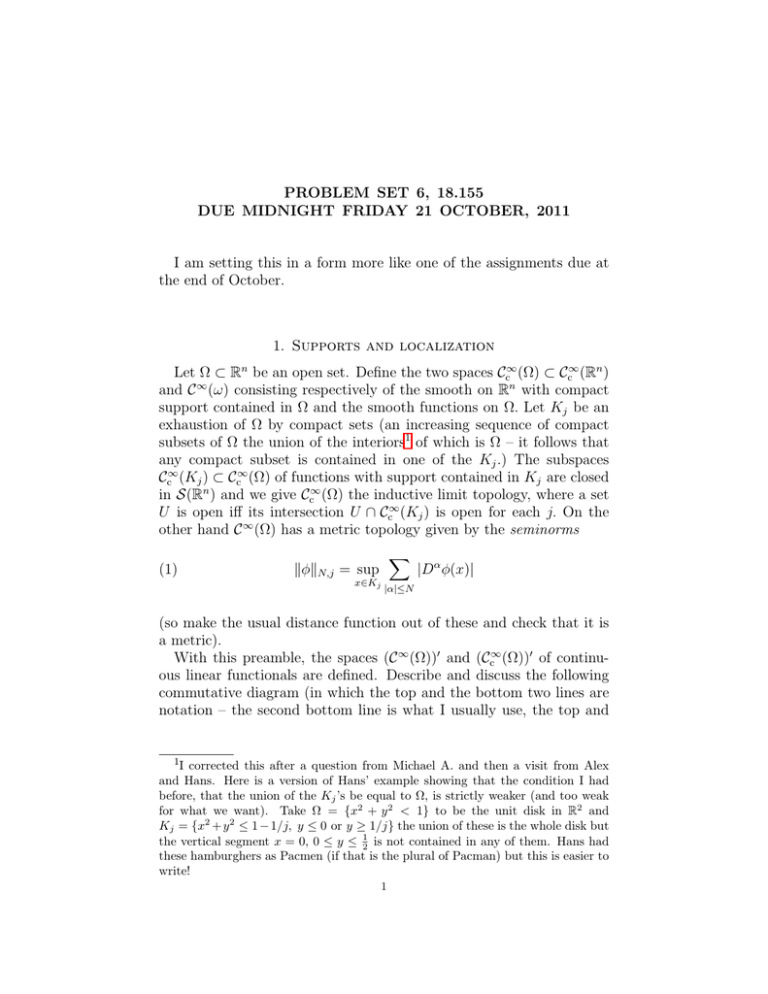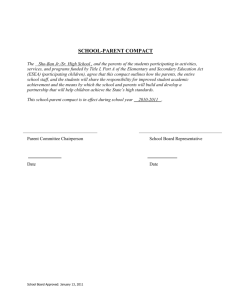PROBLEM SET 6, 18.155 DUE MIDNIGHT FRIDAY 21 OCTOBER, 2011
advertisement

PROBLEM SET 6, 18.155
DUE MIDNIGHT FRIDAY 21 OCTOBER, 2011
I am setting this in a form more like one of the assignments due at
the end of October.
1. Supports and localization
Let Ω ⊂ Rn be an open set. Define the two spaces Cc∞ (Ω) ⊂ Cc∞ (Rn )
and C ∞ (ω) consisting respectively of the smooth on Rn with compact
support contained in Ω and the smooth functions on Ω. Let Kj be an
exhaustion of Ω by compact sets (an increasing sequence of compact
subsets of Ω the union of the interiors1 of which is Ω – it follows that
any compact subset is contained in one of the Kj .) The subspaces
Cc∞ (Kj ) ⊂ Cc∞ (Ω) of functions with support contained in Kj are closed
in S(Rn ) and we give Cc∞ (Ω) the inductive limit topology, where a set
U is open iff its intersection U ∩ Cc∞ (Kj ) is open for each j. On the
other hand C ∞ (Ω) has a metric topology given by the seminorms
(1)
X
kφkN,j = sup
x∈Kj
|Dα φ(x)|
|α|≤N
(so make the usual distance function out of these and check that it is
a metric).
With this preamble, the spaces (C ∞ (Ω))0 and (Cc∞ (Ω))0 of continuous linear functionals are defined. Describe and discuss the following
commutative diagram (in which the top and the bottom two lines are
notation – the second bottom line is what I usually use, the top and
1I
corrected this after a question from Michael A. and then a visit from Alex
and Hans. Here is a version of Hans’ example showing that the condition I had
before, that the union of the Kj ’s be equal to Ω, is strictly weaker (and too weak
for what we want). Take Ω = {x2 + y 2 < 1} to be the unit disk in R2 and
Kj = {x2 + y 2 ≤ 1 − 1/j, y ≤ 0 or y ≥ 1/j} the union of these is the whole disk but
the vertical segment x = 0, 0 ≤ y ≤ 12 is not contained in any of them. Hans had
these hamburghers as Pacmen (if that is the plural of Pacman) but this is easier to
write!
1
2
PROBLEM SET 6, 18.155 DUE MIDNIGHT FRIDAY 21 OCTOBER, 2011
bottom lines are the notation that Schwartz introduced)
(2)
D(Ω)
*
Cc∞ (Ω)
_
E(Ω)
(C ∞ (Ω)) t 0
/
/
S(R n )
|Ω
_
/
S 0 (Rn )
|Ω
/
'
C ∞ (Ω)
_
(Cc∞ (Ω))0
7
Cc−∞ (Ω)
C −∞ (Ω)
E 0 (Ω)
D0 (Ω)
Hints/Remarks
(1) Most of (2) is just definitions but are six spaces and 8 maps to
work on.
(2) On the top row the main thing to check are the injectivity of
the two maps (including the bowed one) from the first space
and the continuity of the two horizontal maps and hence their
bowed composite. It would also be a good idea to check that
the range of the bowed map is dense.
(3) The three vertical maps are all given by the integral of a product
– where one factor is compactly supported in Ω or both are
Schwartz (in the middle column, which we know anyway). You
might like to check that all three have weakly dense ranges.
(4) The lower horizontal maps are dual to the (reflected) upper
ones – you need continuity of these to get the lower maps and
density to get the two lower inclusions.
(5) Say something about the commutativity of the two squares.
(6) What might you add if you were keen? The (weak) density of
the range of the lower bowed map would be a nice thing to check
– you would need something like an exhaustion, a sequence in
Cc∞ (Ω) where the elements are eventually 1 on any compact
subset, to cutoff an element of C −∞ (Ω) to get a sequence with
compact supports.
(7) You could then state some version of the Schwartz structure
theorem – that locally any element of C ∞ (Ω) is the sum of
derivatives of a continuous functio (the number of derivitives
will typically grow near the boundary of Ω.




